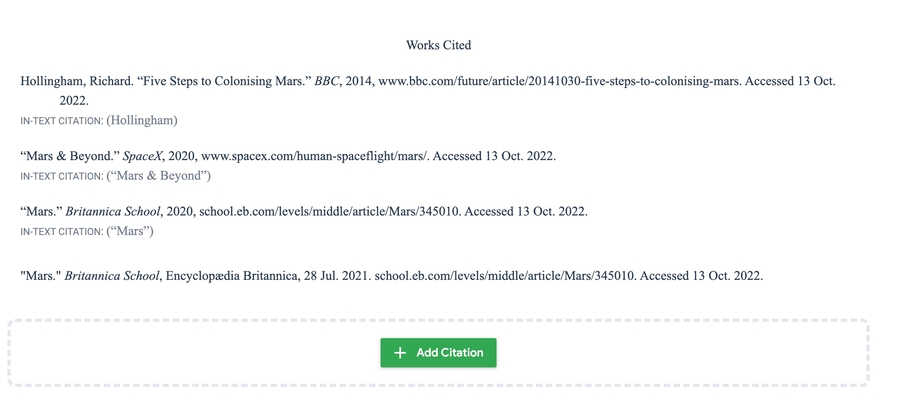In-text Citations
Introduction
Whenever you paraphrase, quote or use information or ideas from a source, you need to include an in-text citation so that anyone reading your work can easily find the original source of the information.
Use in-text citatations to
give credit to the authors of the sources you have used.
increase the credibility of your argument
avoid plagiarism
The Basics
MyBib Guide
You can use MyBib to find what your in-text citation should include, but this will only work if you have added the correct author's name.

MyBib Tip
MyBib will suggest the in-text citations for your sources, but these will only be correct if you have included the correct author and article title in your reference.

Expert Tips
Your in-text citation will always be either the last name of the author, or the name of the article (in quotation marks).
Your in-text citations will never be a website name
Your in-text citations should never be in italics
You should not use a URL inside an in-text citation
Full-stop should appear after the in-text citation (after the last bracket).
Multiple Sources by the Same Author
If you are citing multiple works by the same author, identify which source you are citing from by including a comma after the author’s name, followed by the title (or a shortened version of the title) e.g. (Austen, Pride ).
Co-Authors
For 2 authors, list both authors in the in-text citation:
e.g. (Lin and Lan)
Work Cited
Lin, Tsun-Ju, and Yu-Ju Lan. “Language Learning in Virtual Reality Environments: Past, Present, and Future.” Journal of Educational Technology & Society, vol. 18, no. 4, 2015, pp. 486–497. JSTOR, www.jstor.org/stable/jeductechsoci.18.4.486.
For 3 or more authors, list the the first authorfollowedd by et al.:
e.g. (Yang et al.)
Work Cited
Yang, Fumeng, et al. “A Virtual Reality Memory Palace Variant Aids Knowledge Retrieval from Scholarly Articles.” IEEE Transactions on Visualization and Computer Graphics, 2020, pp. 1–1, 10.1109/tvcg.2020.3009003. Accessed 4 Mar. 2021.
Where should I put my in-text citations?
In-text citations should usually be placed at the end of a sentence.
Manga scholar Mike Hill notes that "the influence of Disney can be seen in the character designs and storytelling techniques used in many manga" (34).
If you quote or paraphrase from two different pages in the same source you can include these in one in-text citation, separated by a colon:
In the period from 1979 to 1999, Hong Kong's film production averaged 133 films annually, while the mainland made less than 100 films per year in the 1980s (127; 134).
If you quote or paraphrase from different sources in one sentence, you can also include these in one in-text citation, separated by a colon:
In a recent study, it was found that "music can have a positive impact on memory recall" and this has been subsequently backed up by research (Green 67; Wang 89).
If you quote or paraphrase from different sources in one sentence, you can place the in-text citation directly after the quotations if needed to link the quotation more clearly to the correct source. You can also do this to clearly distinguish your ideas from those of others.
According to Yip, video game arcades were a common sight in the city (45), while Mak makes the point that "people of all ages were flocking to arcades" (211).
Last updated
Was this helpful?